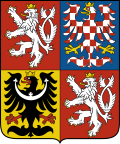Prime Minister of the Czech Republic
 From Wikipedia - Reading time: 10 min
From Wikipedia - Reading time: 10 min
This article needs additional citations for verification. (October 2021) |
| Prime Minister of the Czech Republic | |
|---|---|
| Předseda vlády České republiky (Czech) | |
 | |
since 28 November 2021 | |
| Government of the Czech Republic | |
| Style | Mr Prime Minister (informal) His Excellency (diplomatic) |
| Member of | |
| Reports to | Chamber of Deputies |
| Residence | Kramář's Villa |
| Seat | Straka Academy |
| Appointer | President |
| Term length | Four years, renewable indefinitely |
| Formation | 1 January 1993 |
| First holder | Václav Klaus |
| Salary | 274,800 Kč monthly[1] |
| Website | vlada.cz |
 |
|---|
|
|
The prime minister of the Czech Republic (Czech: Předseda vlády České republiky)[note 1] is the head of the government of the Czech Republic and the de facto leader and most powerful member of the executive branch.[2]
The Constitution provides that certain presidential actions require the prime minister's countersignature, including in appointing judges and ambassadors, commanding the military, ratifying treaties and issuing amnesties.[3]
The current prime minister, Petr Fiala, leader of the ODS, was sworn-in by President Miloš Zeman on 17 December 2021, following the 2021 election and serves as 13th person in the office.
Role
[edit]The prime minister is also authorised to release a member of the government or from confidence, relating to classified information.[4] By virtue of their position, they represent the Czech Republic in the European Council and are entitled to a diplomatic passport.[5]
The prime minister also serves as direct superior of the General Inspection of Security Forces, when they appoint and dismiss its director, who is responsible to them of the performance of their function.[6]
According to Article 63 of the Constitution, the prime minister bears responsibility for signing the decisions together with the entire government of Czech Republic. They can authorise another member of the government to countersign and refuse to co-sign.[7][8]
Powers
[edit]One important power of the prime minister is the possibility of replacing the entire government by their decision and declare a state of emergency. The government must approve or cancel its decision within 24 hours of its announcement.[9] In case a decision-making crisis would pass to the government, the prime minister would decide with Ministry of Defense.[10]
Residence
[edit]The building was built from 1911 to 1914. It was designed by the Viennese architect Friedrich Ohmann.[11]
-
Kramář's Villa seen from the garden
-
View from the garden
-
Home office of the prime minister
List of heads of government
[edit]Notes
[edit]- ^ The formal translation is Chair of the Government. In Czech, the most common term is premiér (Premier), another one is ministerský předseda (Minister-President).
References
[edit]- ^ "Platy od ledna vzrostou o 13 procent. Prezidentovi, ministrům, poslancům i senátorům". Aktuálně.cz (in Czech). 2022-12-19. Retrieved 2023-09-26.
- ^ "The Czech Parliamentary Regime After 1989". Acta Politologica. 8 (2): 5–29. ISSN 1804-1302.
- ^ Article 63
- ^ "Zákon č. 412/2005 Sb". Zákony Pro Lidi (in Czech): 63. 18 October 2015. Retrieved 1 January 2006.
- ^ "Zákon č. 329/1999". Zákony Pro Lidi (in Czech): 13. 27 December 1999. Retrieved 21 December 2023.
- ^ "Zákon č. 341/2011 Sb". Zákony Pro Lidi (in Czech): 1. 23 November 2011. Retrieved 1 January 2012.
- ^ Janek, Daniel. "Kontrasignace aktù prezidenta republiky" (PDF). Masaryk University (in Czech). Brno. Retrieved 7 September 2022.
- ^ "Zeman chce do etické komise donašeče StB, Sobotka jmenování nepodepíše". E15 (in Czech). Czech News Center. 24 January 2017. Retrieved 7 September 2022.
- ^ "Ústavní zákon č. 110/1998 Sb., o bezpečnosti České republiky". Zákony Pro Lidi (in Czech): 5. 29 May 1998.
- ^ Valášek, Lukáš; Kundra, Ondřej (30 March 2020). "Ministr obrany navrhuje v krizi posílení pravomocí premiéra na úkor parlamentu". Aktuálně.cz (in Czech). Prague: Economia.
- ^ "Kramář's Villa". Government of the Czech Republic. 2 October 2006. Retrieved 11 June 2015.
 KSF
KSF


